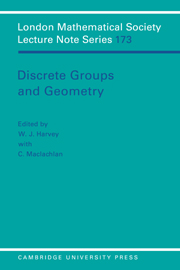Book contents
- Frontmatter
- Contents
- Preface
- Symmetries of modular surfaces
- Lifting group actions to covering spaces
- A combinatorial approach to the symmetries of M and M–l Riemann surfaces
- Inequalities for Pell equations and Fuchsian groups
- The Euler characteristic of graph products and of Coxeter groups
- Infinite families of automorphism groups of Riemann surfaces
- Planar hyperelliptic Klein surfaces and fundamental regions of NEC groups
- An example of an infinite group
- Moduli of Riemann surfaces with symmetry
- Modular groups – geometry and physics
- On automorphisms of free products
- The growth series of the Gieseking group
- Exceptional representations of PSL2(q) of monodromy genus zero
- On the rank of NEC groups
- The geometry of bending quasi-Fuchsian groups
- Farey series and sums of continued fractions
- Commensurability classes of two-generator Fuchsian groups
- Limit points via Schottky pairings
- Diagonalizing Eisenstein series III
- Some remarks on 2-generator hyperbolic 3-manifolds
- Uniformization, graded Riemann surfaces and supersymmetry
- Generating sets for finite groups
- Group actions on trees with and without fixed points
A combinatorial approach to the symmetries of M and M–l Riemann surfaces
Published online by Cambridge University Press: 10 December 2009
- Frontmatter
- Contents
- Preface
- Symmetries of modular surfaces
- Lifting group actions to covering spaces
- A combinatorial approach to the symmetries of M and M–l Riemann surfaces
- Inequalities for Pell equations and Fuchsian groups
- The Euler characteristic of graph products and of Coxeter groups
- Infinite families of automorphism groups of Riemann surfaces
- Planar hyperelliptic Klein surfaces and fundamental regions of NEC groups
- An example of an infinite group
- Moduli of Riemann surfaces with symmetry
- Modular groups – geometry and physics
- On automorphisms of free products
- The growth series of the Gieseking group
- Exceptional representations of PSL2(q) of monodromy genus zero
- On the rank of NEC groups
- The geometry of bending quasi-Fuchsian groups
- Farey series and sums of continued fractions
- Commensurability classes of two-generator Fuchsian groups
- Limit points via Schottky pairings
- Diagonalizing Eisenstein series III
- Some remarks on 2-generator hyperbolic 3-manifolds
- Uniformization, graded Riemann surfaces and supersymmetry
- Generating sets for finite groups
- Group actions on trees with and without fixed points
Summary
Introduction
Let X be a compact Riemann surface of genus g. A symmetry of X is an anticonformal involution T : X → X. The topological nature of a symmetry T is determined by properties of its fixed point set F(T). F(T) consists of k disjoint Jordan curves, where 0 ≤ k ≤ g + 1 (Harnack's theorem). X – F(T) has either one or two components. It consists of one component if X/〈T〉 is non-orientable and two components if X/〈T〉 is orientable. Let T be a symmetry of X and suppose that in F(T) there are k disjoint Jordan curves, then we shall say (see [4]) that the species of T is +k if X – F(T) has two components and –k if X – F(T) has one component.
We shall say that a Riemann surface X is an M (respectively M – 1) Riemann surface if it admits a symmetry with g + 1 fixed curves (respectively g fixed curves). S. M. Natanzon in [9] and [10] announced some properties about the topological nature of the symmetries of M and M – 1 Riemann surfaces and, in the hyperelliptic case, the classification of such symmetries up to conjugation in the automorphism group. Later, in [11] and [12] the above results were proved by topological techniques.
- Type
- Chapter
- Information
- Discrete Groups and Geometry , pp. 16 - 25Publisher: Cambridge University PressPrint publication year: 1992
- 2
- Cited by

